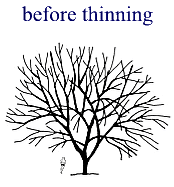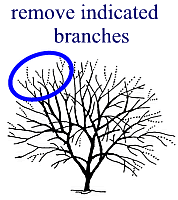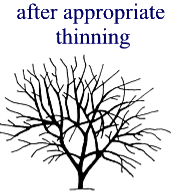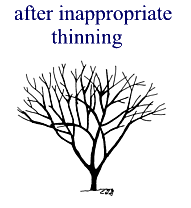Home > Pruning shade trees > Thinning the canopy
Thinning the canopy

 What's really accomplished?
What's really accomplished?
View circled area below as an animation
Photo examples of thinning
Printer friendly (2 page pdf)
Objectives
1) Thinning allows sunlight to penetrate to interior foliage which will help keep interior branches alive. As a result, the diameter of the main branches increases near the trunk (i.e. taper increases) making the main branches stronger. 2) Thinning also can (theorectically) reduce the incidence of some foliage diseases by increasing air flow, and allows more light to reach the ground beneath the tree. 3) More air passes through the canopy instead of pushing against it, so thinned trees move less and receive less damage in storms (See: details of research). However, the effects of thinning are short lived because the tree quickly grows back to fill the canopy with new foliage. Structural pruning is a better method of thinning and managing trees.
Before pruning, the canopy is very dense toward the outer edge. The canopy might be shading desirable plants below. |
Remove small branches (1-3" diameter) from the middle and outside portion of main branches, not from the interior. |
After thinning, the outer portion of the canopy is thinner as a result of removing branches from stems that compete with the leader. Little has changed on the interior of the canopy because few branches were removed from there. |
Removing only lower and interior branches results in a weak tree. This so-called lions-tailing causes problems. DO NOT prune trees in this manner.
|
Introduction
Thinning reduces density of live branches in a tree. The entire canopy can be thinned or just a portion. Thinning increases light penetration and air movement through the canopy and reduces weight. Increased light and air stimulates and maintains interior foliage which can encourage taper (growth in diameter toward the base) on scaffold branches. Thinning toward the tips of a branch can reduce the wind-sail effect of foliar clumps in the crown, and relieve the force on large limbs. Proper thinning should retain canopy shape. Clearing out inner foliage can have adverse effects on the tree and should be avoided. Vigorous production of watersprouts on interior limbs is often a sign of over-thinning or of removing branches from the interior.
Give the most consideration to performing canopy thinning in locations where the root zone is restricted by urban structures such as curbs, streets, sidewalks, and buildings. Roots are often deflected by these structures, making the trees less stable compared to trees in an area where roots can grow unimpeded. Trees in open, exposed, and windy situations also are good candidates for thinning. Thinning can be used to increase the light reaching the ground beneath a tree. Do not remove many live branches, even small ones, from the interior portion of the canopy or from the lower and interior half of the main branches. The size range of parts to be removed, the location in the canopy, and the percentage of live foliage to be removed should be specified by the arborist.
Execution
Thinning does not influence the size or shape of the tree. Thinning should result in an even distribution of branches along individual limbs, not a grouping toward the ends. Do this by removing some of the branches from the edge of the canopy, not from the interior! Caution must be taken not to create an effect known as lion tailing, which is caused by removing an excessive number of interior laterals and foliage. This displaces foliar weight to the ends of the branches and may result in sunburned bark tissue, watersprouts, reduced branch taper, weakened branch structure, and breakage. Before thinning, first, clean the canopy, then proceed with thinning as follows.
Do not remove more than about 15 to 20% of the live foliage on a large tree at one time or sprouting may result. Often 5 to 10% is enough on mature trees. Excessive sprouting can be an indication that the tree was over-pruned. Up to about 25% of the live foliage can be thinned from young trees. Provided you did not remove more than this amount of live foliage while cleaning the canopy, prune small branches from the edge of the canopy. A handsaw or small chain saw is usually the appropriate tool for this job; taking a large chain saw to do this work in the tree can tempt the arborist to remove large diameter branches which would be inappropriate. Thinning is a delicate process that removes small diameter (usually 1-3 inch) branches. Remove those growing parallel and close to nearby branches or those competing for the same space in the canopy. Appropriately thinned trees may not look like they were pruned.





